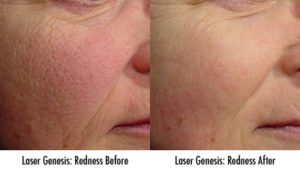We can help!
A common complaint from our patients is redness, flushing, and tiny red veins on the central face. This condition can be cosmetically troubling and may be rosacea which can occur in up to 10 percent of fair-skinned populations. The range of skin findings of rosacea include central face: chronic redness, papules and pustules (resembling acne), telangiectasia (visible, enlarged blood vessels), episodic flushing, burning or stinging, dry, sensitive skin, and at an extreme, severely thickened, coarse skin (phymatous changes, often on the nose). Importantly, some of these vascular findings may also involve the eyes and eyelids and require ophthomalogic consultation.

Also characteristic for rosacea are multiple exacerbating factors that can bring on or worsen the above signs and symptoms. These include: extremes of temperature, alcohol, spicy foods, heightened emotional states, hot beverages, and certain medications/topical irritants.
The cause of rosacea is not entirely clear. Possible contributing factors include: alterations in immune system function, inflammatory reactions to bacteria on the skin, vascular hyperreactivity, and UV-induced changes to the skin. Many of the treatments below have some effect on these factors. Our practice employs a multifaceted approach to the treatment of rosacea to offer patients the best chance of controlling this difficult skin condition.
It is important to see a dermatologist for rosacea because, other than making the clinical diagnosis, it is important to rule out other skin conditions that may look like rosacea, but have different treatment. Acne, along with a number of other medical conditions may also cause redness, flushing and rashes, or have an association with rosacea, and should not be ignored.
Treatment is focused on the primary problem that our patient has, for example, baseline redness versus papules (bumps), flushing, veins, or all the above. Avoidance of exacerbating factors, gentle skin care, and sun protection is vital to start. For continued problems with rosacea, we usually start with a topical cream for redness and flushing like Rhofade or Mirvaso that are very effective at constricting the blood vessels in the skin. Papules can be treated with topical antibiotics, azelaic acid, ivermectin, or retinoids. Oral antibiotics may be added for more severe findings or for patients not responding to creams.
Lasers and intense pulsed light (IPL) devices are an important adjunct or alternative to medical treatment for rosacea. We have been a laser referral center for years and have been using both Lasergenesis or Limelight IPL devices to specifically target the red pigment (hemoglobin) in dilated facial blood vessels or the background redness seen in rosacea. Several treatments are effective at improving telangiectasia and background redness, but physician consultation is necessary given risks of side effects such as burning or skin discoloration.

The overall goal of our management of rosacea is to recognize that it is a chronic skin condition that can have its exacerbations. Therefore longterm follow-up and treatment of some type, or varying types is usually necessary. We have all the options and expertise available to you here at dermatology center of loudoun!

